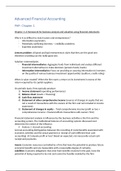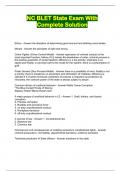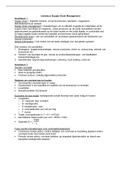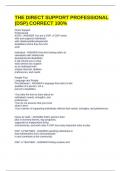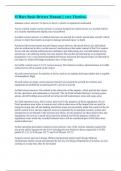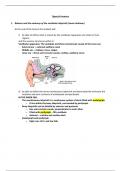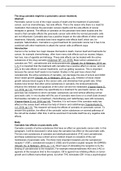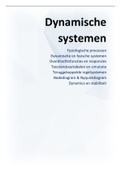Advanced Financial Accounting
PHP: Chapter 1
Chapter 1: A framework for business analysis and valuation using financial statements
Why is it so difficult to match savers and entrepreneurs?
- Information asymmetry
- Potentially conflicting interests – credibility problems
- Expertise asymmetry
Lemons problem: All good and bad entrepreneurs claim that they are the good one,
therefore crowding out the really good one.
Solution: Intermediaries
- Financial intermediaries: Aggregate funds from individuals and analyze different
investment alternatives to make decisions (pension funds, banks)
- Information intermediaries: Focus on providing or assuring information to investors
on the quality of various business investment opportunities (auditors, credit-rating)
When is value created? When the firm earns a return on its investment in excess of the
return required by its capital suppliers.
On periodic basis, firms typically produce:
1) Income statement (operating performance)
2) Balance sheet (assets + financing)
3) Cash flow statement
4) Statement of other comprehensive income (sources of changes in equity that are
not a result of transactions with the owners of the firm and not included in income
statement)
5) Statement of changes in equity – Total comprehensive income (profit or loss +
comprehensive income + financial effects transactions with owners’ firm)
Financial statement analysis is influences by the business activities o the firm and the
accounting system. The institutional features of accounting systems discussed next
determine the extent of the influence.
Feature 1: Accrual accounting
Accrual accounting distinguishes between the recording of costs/benefits associated with
economic activities and the actual payment or receipt of cash (different than cash
accounting) Compute profit or loss? Based on expected, not necessarily actual cash
receipt and payments.
Assets: Economic resources controlled by a firm that have the potential to produce future
economic benefits and are measurable with a reasonable degree of certainty.
Liabilities: Economic obligations that arise from benefits received in the past, have the
potential of being required to be met and cannot be feasibly avoided by the firm
,Equity: Difference between assets and liabilities
Income/Revenue: Economic resources earned (increases in assets that affect equity) and
performance obligations settles (decrease in liabilities affect equity) during a time period.
Governed by realization principle = revenue should be recognized when a) the firm has
provided all goods or services to be delivered to the customer b) customer has paid or is
expected to pay cash with a reasonable degree of certainty.
Expenses: Economic resources used up and economic obligations created during a time
period
Profit or loss: Difference between income and expenses.
Feature 2: Accounting conventions and standards
Several accounting conventions are implemented to ensure that managers use their
flexibility to summarize the business activities instead of using it for self-serving purposes.
Accounting standards regulate how particular types of transactions are recorded.
Feature 3: Managers’ reporting strategy
Firm’s reporting strategy (the manner in which managers use their accounting discretion)
has an important influence on the financial statements.
Feature 4: Auditing, legal liability, and public enforcement
Auditing: Ensures that managers use accounting rules and conventions consistently over
time and that their accounting estimates are reasonable (improves quality of accounting
data).
Legal liability: The legal environment can have a significant effect on the quality of reported
numbers. Potential for significant legal liability might discourage managers from risky
forecasts.
Public enforcement: Public enforcement bodies that initiate reviews of companies’
compliance with accounting standards and take action. Too strict can also reduce the quality
because it may pressure companies to exercise excessive prudence in the accounting
choices.
How can managers communicate with external investors and analysts?
Analyst meetings
Voluntary disclosure (because accounting rules usually prescribe minimum
disclosure requirements). Constraint for expanded disclosure is the competitive
dynamics in product markets. Besides, a constraint is the legal liability of the
management (dissatisfied shareholders)
Financial statement analysis is important because it attempts to get inside information
(management) from public financial statement data:
1) Business strategy analysis
Identify key profit drivers and business risks to assess the company’s profit potential
at qualitative level.
2) Accounting analysis
Evaluate the degree to which a firm’s accounting captures the underlying business
reality
, 3) Financial analysis
Use financial data to evaluate the current/past performance of a firm and to assess
its sustainability
4) Prospective analysis
Forecasting a firm’s future. Two common: financial statement forecasting and
valuation.
A&W: Chapter 1, 2, 3, 4, 7, 18
Chapter 1: Financial reporting and regulation
The annual financial statements typically consist: The statement of profit or loss, balance
sheet, notes to the accounts, statement of cash flows, statement of changes in equity, audit
report.
There are two traditions in accounting that affect regulation and how it is used:
- Anglo-Saxon tradition
- European tradition
Accounting is not a set of precise rules, many choices should be made. There are three types
of encounter between choice and rules:
1) Rules are specific and there is no choice
2) Accounting rules but freedom to make a choice between two/more alternative sets
of rules
3) No rules, decide ourselves
Accounting regulation – regulatory bodies: government (economic management and tax
purposes), stock exchange, private sector body, professional accountants and specialist
industry organization.
International Financial Reporting Standards
- Monitoring Board
- IFRRS foundation
- The Boards
- IFRS advisory council
- IFRS interpretations committee
Standard-setting due process: Research – Discussion paper – Comment analysis – Exposure
draft – Comment analysis – Standard – Effective date
Since 2005, all listed companies in Europe have to use IFRS standards (some exceptions).
Number of developed/developing countries has also already moved to IFRS standards.
IASB Conceptual Framework for financial Reporting (theoretical foundation)
Objective/main purpose of financial reports: Provide financial information about the
reporting entity that is useful to existing/potential investors, lenders and other creditors in
making decisions relating to providing resources to the entity.
PHP: Chapter 1
Chapter 1: A framework for business analysis and valuation using financial statements
Why is it so difficult to match savers and entrepreneurs?
- Information asymmetry
- Potentially conflicting interests – credibility problems
- Expertise asymmetry
Lemons problem: All good and bad entrepreneurs claim that they are the good one,
therefore crowding out the really good one.
Solution: Intermediaries
- Financial intermediaries: Aggregate funds from individuals and analyze different
investment alternatives to make decisions (pension funds, banks)
- Information intermediaries: Focus on providing or assuring information to investors
on the quality of various business investment opportunities (auditors, credit-rating)
When is value created? When the firm earns a return on its investment in excess of the
return required by its capital suppliers.
On periodic basis, firms typically produce:
1) Income statement (operating performance)
2) Balance sheet (assets + financing)
3) Cash flow statement
4) Statement of other comprehensive income (sources of changes in equity that are
not a result of transactions with the owners of the firm and not included in income
statement)
5) Statement of changes in equity – Total comprehensive income (profit or loss +
comprehensive income + financial effects transactions with owners’ firm)
Financial statement analysis is influences by the business activities o the firm and the
accounting system. The institutional features of accounting systems discussed next
determine the extent of the influence.
Feature 1: Accrual accounting
Accrual accounting distinguishes between the recording of costs/benefits associated with
economic activities and the actual payment or receipt of cash (different than cash
accounting) Compute profit or loss? Based on expected, not necessarily actual cash
receipt and payments.
Assets: Economic resources controlled by a firm that have the potential to produce future
economic benefits and are measurable with a reasonable degree of certainty.
Liabilities: Economic obligations that arise from benefits received in the past, have the
potential of being required to be met and cannot be feasibly avoided by the firm
,Equity: Difference between assets and liabilities
Income/Revenue: Economic resources earned (increases in assets that affect equity) and
performance obligations settles (decrease in liabilities affect equity) during a time period.
Governed by realization principle = revenue should be recognized when a) the firm has
provided all goods or services to be delivered to the customer b) customer has paid or is
expected to pay cash with a reasonable degree of certainty.
Expenses: Economic resources used up and economic obligations created during a time
period
Profit or loss: Difference between income and expenses.
Feature 2: Accounting conventions and standards
Several accounting conventions are implemented to ensure that managers use their
flexibility to summarize the business activities instead of using it for self-serving purposes.
Accounting standards regulate how particular types of transactions are recorded.
Feature 3: Managers’ reporting strategy
Firm’s reporting strategy (the manner in which managers use their accounting discretion)
has an important influence on the financial statements.
Feature 4: Auditing, legal liability, and public enforcement
Auditing: Ensures that managers use accounting rules and conventions consistently over
time and that their accounting estimates are reasonable (improves quality of accounting
data).
Legal liability: The legal environment can have a significant effect on the quality of reported
numbers. Potential for significant legal liability might discourage managers from risky
forecasts.
Public enforcement: Public enforcement bodies that initiate reviews of companies’
compliance with accounting standards and take action. Too strict can also reduce the quality
because it may pressure companies to exercise excessive prudence in the accounting
choices.
How can managers communicate with external investors and analysts?
Analyst meetings
Voluntary disclosure (because accounting rules usually prescribe minimum
disclosure requirements). Constraint for expanded disclosure is the competitive
dynamics in product markets. Besides, a constraint is the legal liability of the
management (dissatisfied shareholders)
Financial statement analysis is important because it attempts to get inside information
(management) from public financial statement data:
1) Business strategy analysis
Identify key profit drivers and business risks to assess the company’s profit potential
at qualitative level.
2) Accounting analysis
Evaluate the degree to which a firm’s accounting captures the underlying business
reality
, 3) Financial analysis
Use financial data to evaluate the current/past performance of a firm and to assess
its sustainability
4) Prospective analysis
Forecasting a firm’s future. Two common: financial statement forecasting and
valuation.
A&W: Chapter 1, 2, 3, 4, 7, 18
Chapter 1: Financial reporting and regulation
The annual financial statements typically consist: The statement of profit or loss, balance
sheet, notes to the accounts, statement of cash flows, statement of changes in equity, audit
report.
There are two traditions in accounting that affect regulation and how it is used:
- Anglo-Saxon tradition
- European tradition
Accounting is not a set of precise rules, many choices should be made. There are three types
of encounter between choice and rules:
1) Rules are specific and there is no choice
2) Accounting rules but freedom to make a choice between two/more alternative sets
of rules
3) No rules, decide ourselves
Accounting regulation – regulatory bodies: government (economic management and tax
purposes), stock exchange, private sector body, professional accountants and specialist
industry organization.
International Financial Reporting Standards
- Monitoring Board
- IFRRS foundation
- The Boards
- IFRS advisory council
- IFRS interpretations committee
Standard-setting due process: Research – Discussion paper – Comment analysis – Exposure
draft – Comment analysis – Standard – Effective date
Since 2005, all listed companies in Europe have to use IFRS standards (some exceptions).
Number of developed/developing countries has also already moved to IFRS standards.
IASB Conceptual Framework for financial Reporting (theoretical foundation)
Objective/main purpose of financial reports: Provide financial information about the
reporting entity that is useful to existing/potential investors, lenders and other creditors in
making decisions relating to providing resources to the entity.



